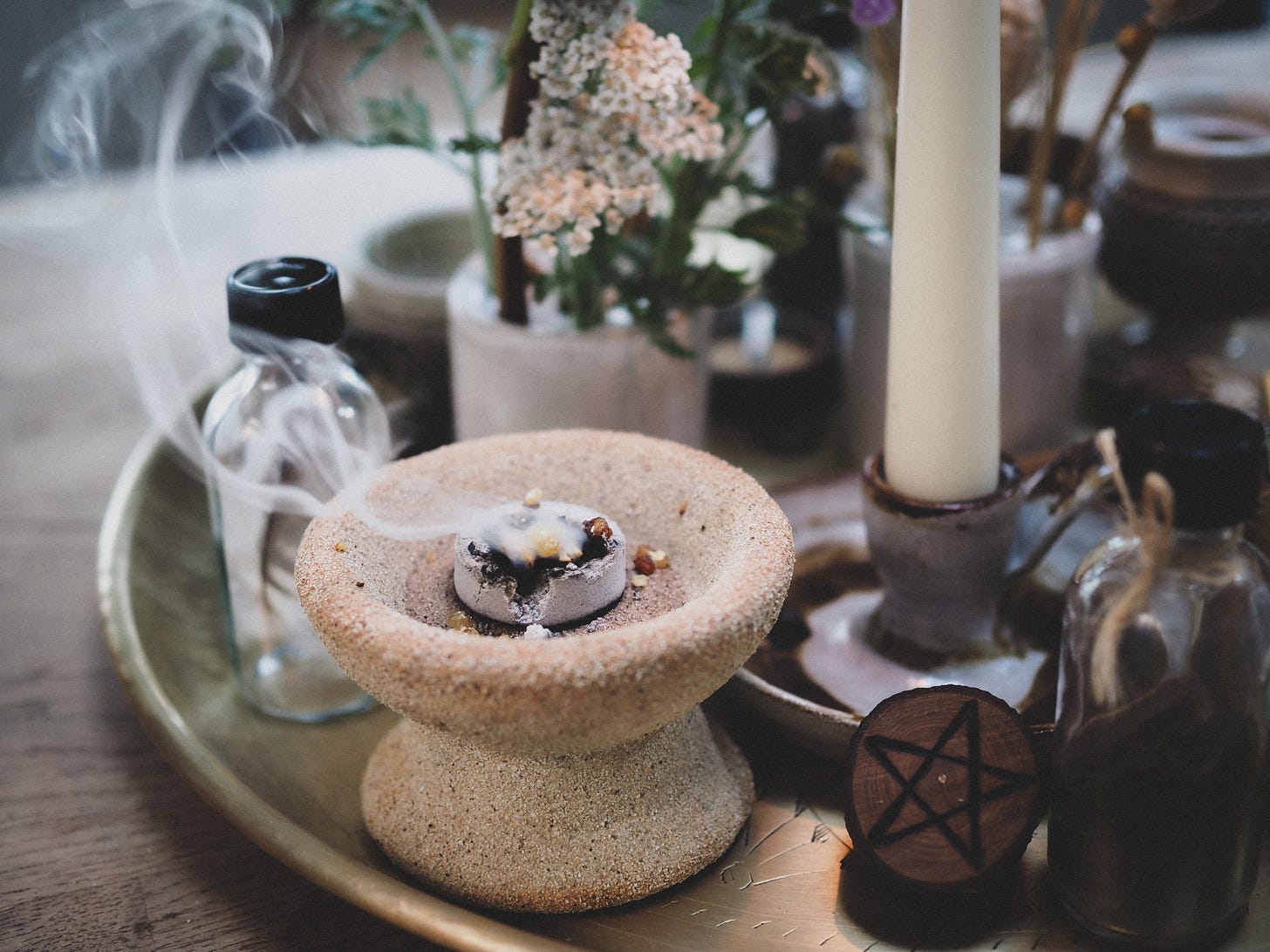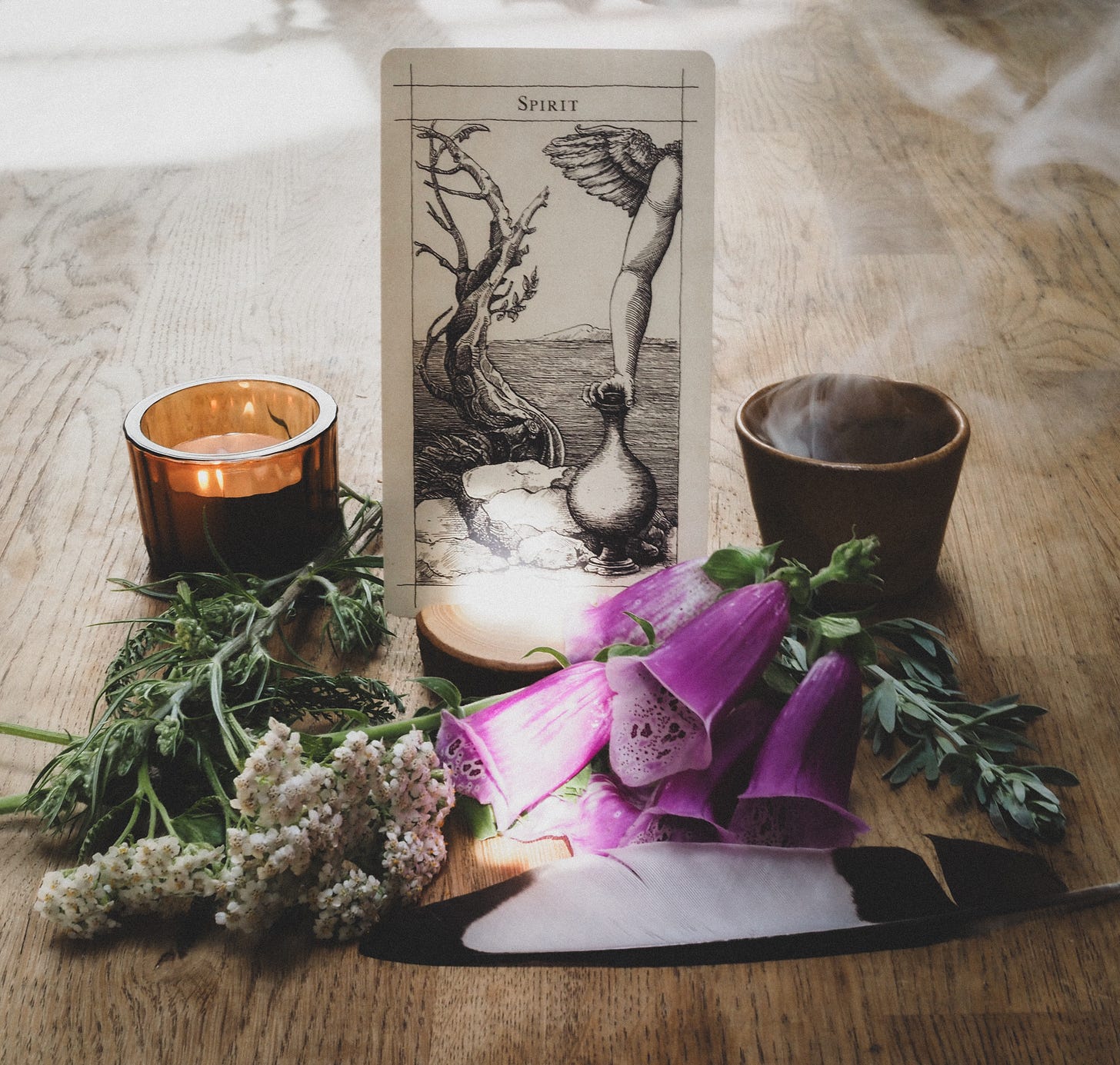I’m Jo, a maker, grower, photographer and practising witch, nurturing a life-long devotional path of weaving nature and ritual into the everyday.
This is a place for seekers of wild edges, feral beauty and those who are drawn to witchcraft; whether that’s curiosity, or knowing that you’d like to create your own meaningful practice.
Subscribe to learn how to find wisdom in nature’s elements and cycles, with twice monthly guides and tales from the woods, garden and hearth.
Gather in and deepen your relationship with the natural world, where the heart meets the earth.
There are many ways of creating a sacred space and many places where you could do this. Perhaps it’s by ourselves, maybe it’s with other people? It could be creating it within ourselves, seeing our bodies and minds as sacred spaces. But this inner work takes time and practice and it’s not something I have been able to achieve as yet! But in my experience using an altar at home, with a clear intention and a heartfelt invocation is a way of creating a sacred space, one where we can open ourselves up to other levels of our being rather than sitting in a never ending cycle of to-do lists.
What is an altar? According to the Cambridge Dictionary definition, it’s: a structure with a flat top, often shaped like a table, that is used in some religious ceremonies, for example as a place to put important religious objects.
I prefer to think of it more as a collection of meaningful objects that provides a focus for the sacred in your life.
I use my altar as a focal point in rituals or ceremonies. But you could create a sacred space without including either of these things.
An altar can be used as a tool for connection to the self where the emphasis is on feeling rather than thinking.
How to Create an Altar
There’s no right or wrong way of doing it. Use whatever you feel has meaning and significance. It could be a set of objects which you bring out every now and then or it could be a dedicated space inside your home, or outdoors on a balcony or in a garden.
What could you include? Treasures found on a walk in nature, a representation of each of the elements, precious items, feathers, candles, tarot or oracle cards, flowers, seedheads, shells, crystals, incense, photos, statues, pictures, divination tools, or even a sacred object that you’ve made.
Once you’ve collected your objects together, you could create your altar on the floor/ground, on a tray that you can move around, a low table, a tree stump, a shelf, a window ledge, in a favourite corner of the garden, or on a mantel piece. You could also lay everything out on a square scarf, or piece of cloth, on the carpet. You could keep it out if you have the space, or bring it out for a particular purpose. It’s up to you.
It’s not about spending money on having the ‘right’ things, because there are no ‘right’ things. The whole purpose of this is to create something meaningful and personal that you can feel connected to. Your altar doesn’t have to be elaborate. Have a go at using what you already have at home. If you need something that you don’t have, try getting it second hand from charity shops, or vintage stalls. Or perhaps have a go at making something if you enjoy being creative.
Although I completely understand the attraction of it looking visually appealing, the most important part of creating an altar is the meaning of the space. You don’t need to spend any money to do this and it can still be beautiful.
What I have on my main altar and why
My main altar is set up as a tray of objects, all derived from Wicca. I keep this out as often as possible, although due to lack of dedicated space it does get packed away from time to time! My altar at home is separate from our coven altar, although I use similar symbolism (albeit with a few of my own meaningful objects). These are the objects I use:
A pentagram representing the four elements, governed by the fifth: spirit.
Symbols of the esoteric elements of air, fire, water and earth, representing the basic modes of existence. Plus spirit which integrates them all.
North is earth and I use soil. For east it’s air and I use feathers. For south, the element of fire, I use dried twigs, and for the west it’s water. Depending on the ritual I also add tea light candles marking these points. I also have a compass as a reminder of the way to the elements. (I will go into more detail about ways of invoking the four elements in another post).
An altar candle that I use in rituals, spells or as a focal point for intentions. Lighting a candle can also represent shifting out of everyday energy into a peaceful state.
A small goblet with wine, mead, fruit juice or water; with a dish for libations. Libations are offerings, either poured indoors into a dish, or if working outdoors poured onto the ground. They are used in ceremonies and rituals as offerings to deities. I also offer a libation to toast the ‘Old Ones’ (ancestors) and those who have gone before us, asking for their guidance.
I have a small salt cellar, along with a bowl of water. The salt is added to the water for consecration, purification and protection of a space. Symbolically salt is seen as a cleanser and is used in the casting of a circle.
An athame which is a Wiccan tool. I use it when I’m casting a circle, drawing the shape of a circle with it at the beginning of a ritual. I also use it to draw a pentagram when ‘calling the quarters, and invoking the elements.
A censer + incense. I think of incense as taking intentions out into the ether, with thoughts and invocations rising up with the smoke. I also use incense for consecration along with salted water. Incense can also be used to represent the element of air.
I have a small bell as a marker for different parts of the ritual. The vibrations of sound supplement the energy raised.
Two small vases, one with dried seedheads and flowers and one with fresh flowers or foliage. These represent macrocosm and microcosm; cosmos and human; outer worlds and inner worlds; and life and death. Opposites that make up the whole.
Anointing oil and dish. This is for blessing and consecration of others who might be with me and also myself. It helps to create a connection. It’s simply a few drops of essential oils in a carrier oil.
A circle carved in wood. This is a representation of spirit. The endless infinite. No beginning and no end.
Some of these altar items were things I made, some were gifts, and some have been collected over the years from charity shops.
The idea of stillness and calm doesn’t fit everyone, so if this isn’t your vibe, find a way of creating a sacred space that works for you. I also think that straining to empty your mind of thoughts or trying to think of nothing at all ends up feeling too impossible to bother with. Whereas looking at a few meaningful objects and feeling a connection to them can help move our thoughts towards something expansive.
If you find that you need something to say to yourself as you begin, try this invocation:
The Threshold
As I enter this space,
I hope to feel held and protected
My intention is to connect to my innermost place,
using the objects here as tools, to bring quiet moments of calm within
I hope that I will find what I am seeking
I hope that I will recognise what I need to know the most
I cannot force my mind to be where I think it should,
so I ask for patience with myself
In this sacred space I ask to feel safe and at peace,
loving and loved,
to feel my heart and spirit lift
in harmony with the earth.Creating a sacred space gives us the chance to step out of our normal day-to-day demands, halting the flow of daily life even for a few minutes, opening up to subtle shifts in our awareness.
Thank you for reading.
Until next time,
Jo











